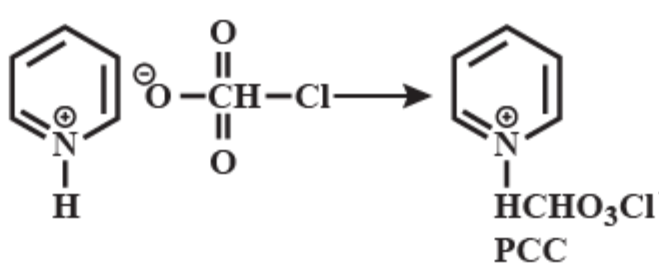
The formula of PCC is:
A.

B.

C.

D.





Answer
450.9k+ views
Hint: We know that PCC stands for pyridinium chlorochromate. Pyridinium chlorochromate is formed by the reaction of pyridine and chromium oxide, hydrochloric acid. You can now protonate the nitrogen atom present on the pyridine molecule and then perform the reaction. Based on this you can determine the possible structure of PCC i.e. pyridinium chlorochromate.
Complete step by step solution:
Pyridinium chlorochromate (PCC) consists of a pyridinium cation,

PCC is the most suitable reagent to oxidize primary alcohol to aldehydes and secondary alcohols to ketones without affecting any other functional group. Thus it offers any other functional group. In fact, it is more selective than the related Jones reagent, so there is little chance of over-oxidation to form carboxylic acids as long as the water is not present in the reaction mixture. It also converts suitable unsaturated alcohols and aldehydes to cyclohexanes. One disadvantage to the use of PCC is its toxicity. Another more convenient or less toxic reagent for oxidizing alcohols is dimethyl sulfoxide. PCC is soluble in solvents like acetone, acetonitrile.
Therefore, the correct answer is option B.
Note:
Remember that Generally, confusion may arise to choose in between options a and b. Pyridinium chlorochromate is formed by combining the compounds, pyridinium cation
Complete step by step solution:
Pyridinium chlorochromate (PCC) consists of a pyridinium cation,

PCC is the most suitable reagent to oxidize primary alcohol to aldehydes and secondary alcohols to ketones without affecting any other functional group. Thus it offers any other functional group. In fact, it is more selective than the related Jones reagent, so there is little chance of over-oxidation to form carboxylic acids as long as the water is not present in the reaction mixture. It also converts suitable unsaturated alcohols and aldehydes to cyclohexanes. One disadvantage to the use of PCC is its toxicity. Another more convenient or less toxic reagent for oxidizing alcohols is dimethyl sulfoxide. PCC is soluble in solvents like acetone, acetonitrile.
Therefore, the correct answer is option B.
Note:
Remember that Generally, confusion may arise to choose in between options a and b. Pyridinium chlorochromate is formed by combining the compounds, pyridinium cation
Latest Vedantu courses for you
Grade 10 | CBSE | SCHOOL | English
Vedantu 10 CBSE Pro Course - (2025-26)
School Full course for CBSE students
₹37,300 per year
Recently Updated Pages
Master Class 12 Economics: Engaging Questions & Answers for Success

Master Class 12 Maths: Engaging Questions & Answers for Success

Master Class 12 Biology: Engaging Questions & Answers for Success

Master Class 12 Physics: Engaging Questions & Answers for Success

Master Class 12 Business Studies: Engaging Questions & Answers for Success

Master Class 12 English: Engaging Questions & Answers for Success

Trending doubts
Which are the Top 10 Largest Countries of the World?

a Tabulate the differences in the characteristics of class 12 chemistry CBSE

Why is the cell called the structural and functional class 12 biology CBSE

Differentiate between homogeneous and heterogeneous class 12 chemistry CBSE

Derive an expression for electric potential at point class 12 physics CBSE

What are the major means of transport Explain each class 12 social science CBSE




